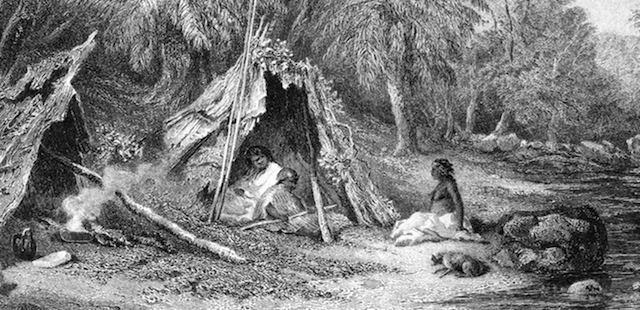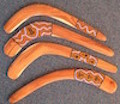



Shell middens are sites where the remains of countless meals of shellfish have piled up over hundreds of years. Not only do they give us an insight to aboriginals’ diets but they indicate where aboriginal coastal dwellers may have taken shelter. The Botany Bay shell midden has the remains of fish bones, muscles, fish hooks, spear barbs and charcoal from camp fires. Fish hooks around this area were made of turban shell and wood, curved but not barbed. It is believed that the shine from the inner turban shell lured fish to the hook.
This grinding stone is made of sandstone and was found along the shores of the darling river. The tool was used by indigenous woman to grind seeds and shrubs in order to produce flour. This could then be mixed with water to create a loaf of bread or paste. Large ones like these were left at the campsite and smaller ones were carried around between sites. Grinding stones are very similar to the pestle and mortar, still used today for grinding herbs.
The death spear was a weapon used for hunting large animals and human combat. Death spears have a central wooden shaft with a number of small sharp almost blade like pieces of stone about 3 cm long and pointing backwards. These ‘backed blades’ were used to lodge the spear into the victim, sever arteries and cause great blood loss. Backed blades would tend to break off the spear and remain in the victim's flesh.This is one of the backed blades found in 2005 at the site of the brutal killing of Narrabeen man some 4,000 years ago. Several death spears were used to kill Narrabeen man and evidence of many backed blades have been found lodged in his vertebrae.
Hunting boomerangs are shaped differently to and usually heavier and larger than returning boomerangs. Many hunting boomerangs have one arm much longer than the other, so they do not fly in a circular path but are easier to aim, fly faster and are more deadly to kill animals. Another type of boomerang is the cross boomerang. Shaped like a cross with two flat wooden pieces tied together with lawyer cane. This type was only made and used by people in the rainforest areas of Northern Queensland. It had sharp edges and was mainly used to hunt small rainforest birds because it was small enough to get around the trees. This boomerang on display is a returning boomerang. Notice the V - shape arms indicating a returning boomerang.
Shaped like a cross with two flat wooden pieces tied together with lawyer cane. This type was only made and used by people in the rainforest areas of Northern Queensland. It had sharp edges and was mainly used to hunt small rainforest birds because it was small enough to get around the trees. This boomerang on display is a returning boomerang. Notice the V - shape arms indicating a returning boomerang.